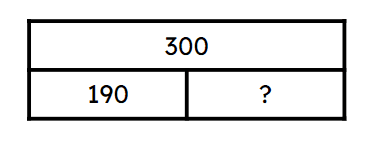Myths about teaching can hold you back
- Year 3
Solve problems involving length and height
I can solve problems about lengths and heights.
- Year 3
Solve problems involving length and height
I can solve problems about lengths and heights.
These resources were made for remote use during the pandemic, not classroom teaching.
Switch to our new teaching resources now - designed by teachers and leading subject experts, and tested in classrooms.
Lesson details
Key learning points
- Word problems can be represented in a bar model by identifying the parts and the whole.
- To find the whole, we need to add the parts together.
- To find a part, we need to subtract the part we know from the whole.
- If the units are different, they need to be converted to the same unit.
Keywords
Bar model - A pictorial representation of a problem where bars are used to represent the known and unknown quantities.
Part - Some but not all of something. It is an amount or section which, when combined with others, makes up the whole.
Whole - All of something. It is complete.
Common misconception
Converting between units; interpreting a word problem; confusing parts and wholes.
When representing as a bar model, visualise the problem to help determine what the parts are and what the whole is.
To help you plan your year 3 maths lesson on: Solve problems involving length and height, download all teaching resources for free and adapt to suit your pupils' needs...
To help you plan your year 3 maths lesson on: Solve problems involving length and height, download all teaching resources for free and adapt to suit your pupils' needs.
The starter quiz will activate and check your pupils' prior knowledge, with versions available both with and without answers in PDF format.
We use learning cycles to break down learning into key concepts or ideas linked to the learning outcome. Each learning cycle features explanations with checks for understanding and practice tasks with feedback. All of this is found in our slide decks, ready for you to download and edit. The practice tasks are also available as printable worksheets and some lessons have additional materials with extra material you might need for teaching the lesson.
The assessment exit quiz will test your pupils' understanding of the key learning points.
Our video is a tool for planning, showing how other teachers might teach the lesson, offering helpful tips, modelled explanations and inspiration for your own delivery in the classroom. Plus, you can set it as homework or revision for pupils and keep their learning on track by sharing an online pupil version of this lesson.
Explore more key stage 2 maths lessons from the Measuring length and recording in tables unit, dive into the full primary maths curriculum, or learn more about lesson planning.

Licence
Prior knowledge starter quiz
6 Questions
Q1.A standardised unit of measure that is equivalent in length to 100 cm is called a .
Q2.Match the calculation to its answer.
40
60
160
100
Q3.Match the equivalent measures.
101 cm
110 cm
110 mm
200 cm
Q4.Match the calculation to its answer.
22 cm
80 cm
100 cm
150 cm
Q5.Starting with the shortest, put these lengths in order.
Q6.Look at this bar model. Find the missing part.

Assessment exit quiz
6 Questions
Q1.Look at this word problem and empty bar model. Match the given lengths to the whole or a part.

The whole.
A part.
Q2.Use the bar model to support you to identify the calculation, and then solve the problem. Choose two correct answers.

Q3.Use the bar model to support you to identify the calculation, and then solve the problem.

Q4.Izzy's sunflower is 3 m 90 cm tall. Andeep's is 200 cm tall. How much taller is Izzy's sunflower than Andeep's? Choose all possible options.
Q5.Use the bar model to support you to identify the calculation, and then solve the problem. Choose all possible options.



